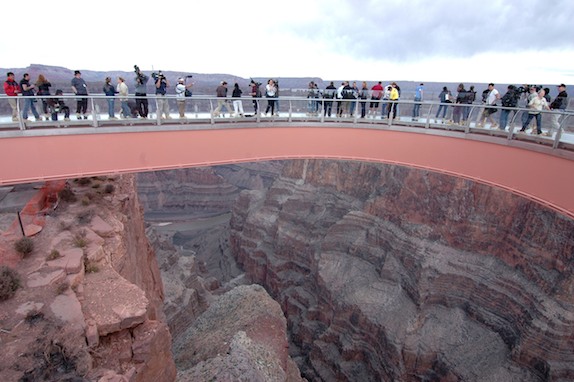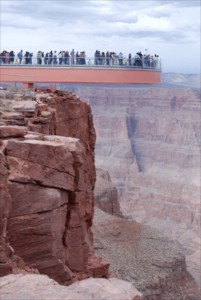
Stretching into the air 4000 feet above the Colorado River is the Grand Canyon Skywalk. It is the spectacular featured attraction on the Grand Canyon West Resort, which is operated by the Hualapai Indians. This U-shaped, glass-bottomed bridge was completed in 2007 and extends straight out 70 feet from the rim of the canyon. It provides a view and an experience like none other, which is why hundreds of thousands of visitors from all over the world flock to it every year, despite its somewhat remote location. If the chance to “walk in space” appeals to you (Astronaut Buzz Aldrin was featured at its opening!), this might just be the ticket for you. It offers you a unique experience of the canyon, but count on sharing it with a lot of other folks, especially in summer.
The Skywalk is open 365 days a year, including major holidays.
April to September: 7:00 am to 7:00 pm
October to March: 8:00 am to 5:00 pm
The Skywalk and Grand Canyon West Resort form the major economic development initiative for the Hualapai (“People of the Tall Pines”), who have inhabited this land for many centuries. Planners see this as a positive alternative to the casinos that are the primary economic engines for many other Indian tribes. The complex currently includes a welcome center with a café, gift shop, espresso bar, ticketing and concierge services, shuttle station, and air tour terminal.
If you’re among those who like to learn “how stuff works,” you may be fascinated by how engineers solved the unusual challenges of safely sticking a huge platform into the side of the canyon. The cantilevered structure is supported entirely by horizontal steel beams weighing more than a million pounds anchored deep in the canyon walls. The glass bottom and walls are four inches thick and constructed in six layers. The Skywalk was designed to hold 72 tons – far more than the weight of the 120 people who are permitted to walk out on it at any one time – and to withstand an 8.0 magnitude earthquake 50 miles away. The structure was engineered to withstand high winds, too. All in all, it is something of an engineering marvel—and a construction marvel, too, considering the challenges of getting all the equipment and the materials to this remote site.

The Skywalk and Grand Canyon West are situated on the Hualapai Indian Reservation and are not part of the Grand Canyon National Park. The experience of getting there and entering the reservation is therefore different from the typical national park experience. The ten-mile access road is partially unpaved and does not reliably appear on most GPS devices.
Additionally, the fees to enter the reservation and its attractions are considerably higher than at national park facilities. Since fees are subject to change, check them before you go. Expect to pay for “legacy pass” that entitles you to enter the Hualapai lands and gives you access to points of interest, parking, and the shuttle busses that circulate regularly. Entrance to the Skywalk requires an additional admission fee. You will not be permitted to bring your camera or any personal effects onto the bridge. You’ll need to store your belongings in a locker, and if you want photos, plan to pay for one of the Skywalk professionals to take them for you. You’ll also need to bring money for food, since you will not be permitted to bring any food or beverages onto the reservation.
Tours can eliminate some of the travel challenges. You’ll find many available, taking you in by motor coach, helicopter, or airplane, with a variety of options regarding the length of your stay, the sights you’ll see, where you’ll stay, and what you’ll eat.